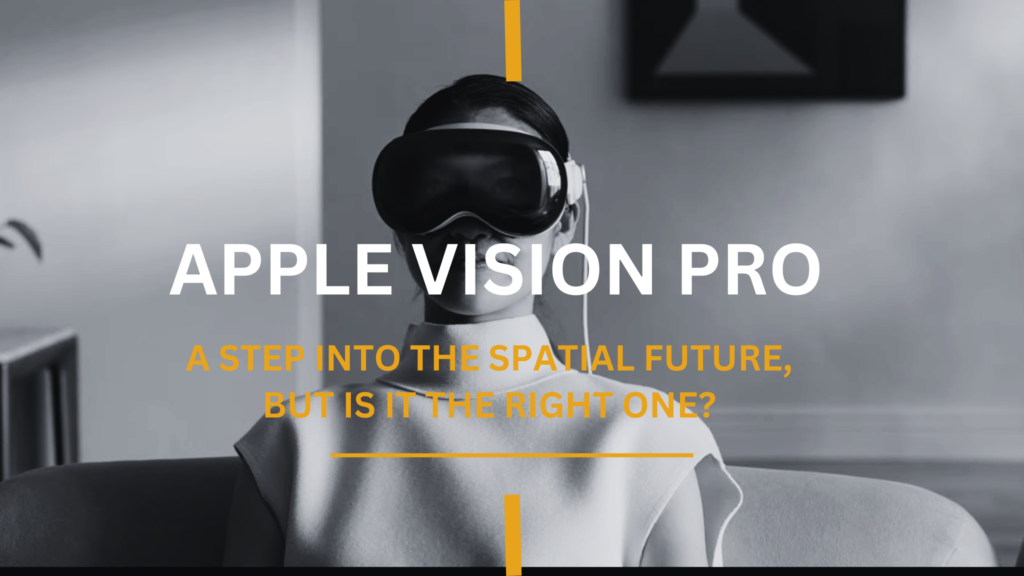Get ready, folks, because the future of computing is about to get a whole lot more… spatial. With the release of the Apple Vision Pro in just a few weeks, the tech world is buzzing with excitement and, of course, questions. Launching in February 2024, it promises a revolutionary experience, blurring the lines between the digital and physical worlds. But is it really a game-changer, or does it stumble in its ambition? Let’s dive into the pros and cons to help you decide if the Vision Pro is worth the hefty $3,499 price tag.
What is Apple Vision Pro?
Imagine a seamless blend of the physical and digital worlds. That’s the promise of Apple Vision Pro, a mixed reality headset that overlays digital experiences onto your real-world view. It’s not just virtual reality (VR) that cuts you off from your surroundings; it’s a bridge between the two, blurring the lines of what’s “real” and what’s “digital.”
So, what can you do with this fancy headset?
- Work in a whole new dimension: VisionOS, the custom operating system, offers an infinite canvas for your apps. Picture floating windows at any scale, collaborating with colleagues in virtual spaces, and presenting like never before.
- Relive memories like never before: Capture spatial photos and videos, then immerse yourself back in those moments with lifelike depth and 3D audio. Panoramas become portals, transporting you right back to that breathtaking vacation spot.
- Entertainment reimagined: Watch movies on a screen that feels 100 feet wide, with sound that adapts to your environment. The lines between watching and experiencing disappear entirely.
- Connect without barriers: FaceTime takes on a whole new meaning with eye tracking technology. Make eye contact, share virtual spaces, and feel truly present, even when miles apart.
Pros:
- Stunning Visuals and Immersion: The dual high-resolution displays boasting over 23 million pixels, coupled with the M2 chip, deliver crystal-clear visuals and smooth performance. Spatial Audio further enhances the experience, making you truly feel like you’re stepping into another world.
- Infinite Workspace: Gone are the days of cramped desktops. VisionOS reimagines how we interact with apps, offering a three-dimensional workspace where apps float around you at any scale. This opens up doors for unparalleled multitasking and productivity.
- Memories Come Alive: Capture photos and videos in stunning 3D, then relive them with mind-blowing depth and realism. Spatial videos transport you back to a moment in time, making you feel like you’re right there again.
- Advanced Eye Tracking: The Vision Pro’s EyeSight feature is a game-changer for interaction. Glance at an app or button, and it subtly responds, making navigation intuitive and natural. You can even maintain eye contact while in virtual experiences, fostering genuine human connection.
Cons:
- Steep Learning Curve: VisionOS is a paradigm shift from traditional interfaces. Adapting to its 3D space and gesture controls takes time and effort. Newcomers might be frustrated by the initial learning curve.
- Content Scarcity: The Vision Pro is a pioneer in this space. While Apple promises a growing library of apps and experiences, the current selection is limited. Users might lack the content they crave at launch.
- Isolation Concerns: Immersing ourselves in virtual worlds raises concerns about social isolation and neglecting the real world. Apple attempts to address this with EyeSight, but the long-term implications need to be considered.
- High Price Point: At $3,499, the Vision Pro is a luxury. While its technology is impressive, this hefty price tag will likely make it accessible only to early adopters and professionals, limiting its initial market reach.
Market Impact:
Vision Pro’s impact on the mixed reality market is undeniable. It raises the bar for visual fidelity, interaction, and user experience, pushing competitors to innovate and evolve. This could lead to a new era of immersive computing, where virtual and physical worlds blend seamlessly.
However, Vision Pro’s success hinges on overcoming its limitations. Building a robust app ecosystem and addressing user concerns about content scarcity and isolation are crucial for widespread adoption. The price point also plays a significant role. A more affordable version could open up the market to a wider audience and accelerate the technology’s growth.
Competitors Take Note, User Perceptions Matter:
As the dust settles around Vision Pro’s launch, competitors need to pay close attention to user perceptions. Understanding what users like and dislike about the device, along with their expectations for the future of mixed reality, is crucial for developing winning strategies.
This is where iMAD Research comes in. Our global online panel and network of affiliates provide the tools and expertise to gather valuable user insights from around the world. We can help you:
- Track user sentiment towards Vision Pro: Understand what resonates with users and identify areas for improvement.
- Gauge future market potential: Get insights into user preferences and expectations for upcoming mixed reality products.
- Refine your own offerings: Use user feedback to develop products and experiences that truly meet user needs.
By leveraging iMAD’s research capabilities, competitors can stay ahead of the curve and prepare for the next wave of innovation in mixed reality.
Conclusion:
Apple Vision Pro is a technological marvel, offering a glimpse into the future of computing. However, its success depends on overcoming initial hurdles and catering to user needs. Competitors have a golden opportunity to learn from Vision Pro and shape the future of this exciting technology. Understanding user perceptions through research is key for building products that truly capture the hearts and minds of consumers. iMAD Research stands ready to help you navigate this new frontier and unlock the full potential of mixed reality.
The road ahead for mixed reality is full of possibilities, and Apple Vision Pro has planted its flag as a pioneer. Will it redefine the way we interact with the world, or will it be a stepping stone for even greater things to come? Only time will tell, but one thing is certain: the future of computing just got a whole lot more immersive.






